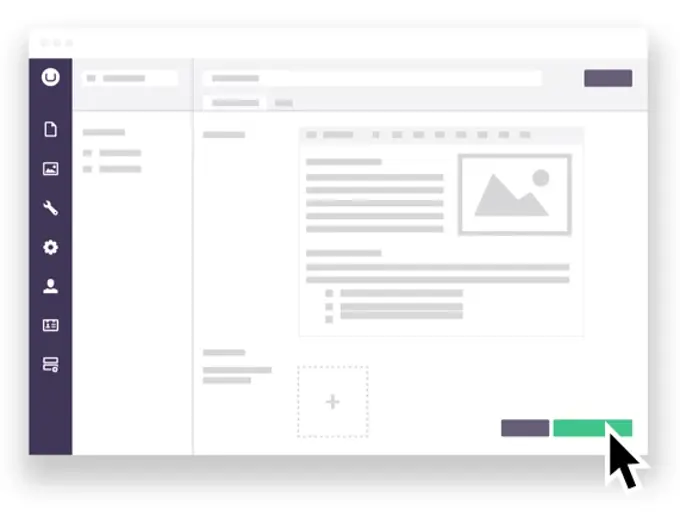What is a digital experience platform (DXP)?
It is no secret that the world of content management systems (CMS) is full of acronyms, and some are just buzzwords. But occasionally, a few of these sticks around and become the next big thing. And that is the case with DXP (digital experience platform).
In this knowledge base article, you will be introduced to the Digital experience platform (DXP) and how it relates and differentiates itself from a Content Management System (CMS).
What is a CMS?
A CMS is a software used by businesses to create and modify content on their website to boost their online presence. A CMS traditionally handles text, images, video, and audio content. We have written a full-length article on “What is a CMS?” if you want more information on this topic.
Typically the CMS will consist of a backend to edit the content and a front-end, where your visitors can see it.
Over the years, the market demand for content personalization and omnichannel marketing has risen. Some content management systems come pre-packaged with these features, more or less successfully. However, the request for personalization and experience management is often fulfilled with other types of software, resulting in an increasing marketing technology stack. And now enter the digital experience platform.


What is a digital experience platform?
The digital experience platform (DXP) has evolved from the need for more advanced features than the traditional CMS offers.
Users of CMS applications want personalized experiences and the capability to anticipate the actions or needs of their website visitors even before they realize it themselves.
Most content management systems don’t offer these capabilities out of the box but require investments in add-ons and integrations. This is where the digital experience platforms come in. They are built for creating digital experiences across websites, apps, and other digital touchpoints that go beyond managing your content.
What are the features of a digital experience platform?
The components of a DXP will vary from organization to organization, but here are a few of the typical features you can find in a DXP:
- CMS
You can create and manage your content. But that’s no longer enough. To get the most out of your website, you need additional software in your tech stack. That’s what a DXP does - DAM - Digital Assets Management
To manage all your digital assets like videos, images, etc. - PIM - Product Information Management
If you’re an eCommerce company a PIM can help you handle your product information - Personalization and A/B testing
To serve relevant content for your visitor - Analytics
So you know how your website is performing - CRM - Customer Relationship Management
You need to generate digital business that happens in a CRM - Ecommerce
If you’re selling products online - Campaigns
To manage your email and social media campaigns - Presentation layer
Control over how it is all presented to the user, through various “heads” if headless
Should I choose a CMS or a DXP?
Now you might think that a DXP solution is superior to a CMS, and the DXP way is the only way. But this is not the case. There’s so much more to this discussion. A DXP is essentially an evolved CMS.
The CMS is centralized around content management to help you create excellent website experiences. The DXP will centralize all you need to work with the digital experience.
To determine if you need a DXP, we must distinguish between a website and the digital experience. Some customers will get in touch through your website, some through social media platforms, and others through email or telephone. The important note here is that your customers will have different touchpoints throughout their journey, and that’s where the DXP can help you connect it.

Different types of digital experience platforms
Content management systems come in many shapes and sizes. First of all, there are various frameworks and coding languages that systems use. The most common ones are .NET and PHP.
Secondly, and most similar to DXP platforms, there is a difference in how it is made available to you.
On the one hand, you have free, open-source versions. These allow you to modify the source code and offer open APIs that you can use to integrate with your preferred tech stack.
On the other hand, you have closed source systems (also known as proprietary). These provide a closed environment and will limit your options for integrating other systems from your tech stack.
The same differences can be found in digital experience platforms, where you have the Composable DXP on the one hand and the Monolithic DXP on the other.
Let’s take a closer look at each below, and compare the differences.
What is Monolithic DXP?
The monolithic approach to DXP, is the traditional way of expanding a proprietary CMS into a full-fledged DXP with a prepackaged software suite. This gives you an all-in-one software suite. The monolithic offerings often have one approach to setting up workflows and structures on how they are implemented.
With monolithic digital experience platforms, one vendor is in control of everything. All features are in the same dashboard or suite, and it’s often hard to integrate these tools with other tools that are not a part of the package.
The monolithic approach is perfect if you handle everything from one place. It also offers the benefit of requiring less work to set up because it’s all tightly integrated and controlled by the same vendor. However, it can be tricky to change one of the tools to another tool that is not a part of the vendor's suite. If you want more control over your tech stack, you should look at a Composable DXP instead.


What is Composable DXP?
The composable Digital experience platform (DXP) is one of the newer terms in digital development. It describes a digital experience platform with a series of “best-of-breed” solutions.
You might ask, “what is “best-of-breed” software?”
Best-of-breed is the best software in its niche or category that performs specialized functionality better than a system that tries to do everything out of the box. It does not try to be a swiss army knife with a lot of functionality. Instead, it is the best tool for the purpose.
The term composable comes from the software architecture concept of composability. It is a paradigm where services and components are decoupled as interdependent modular parts.
When it comes to the composable DXP, it emphasizes the principles of MACH architecture.
In MACH architecture, the focus is on Microservices, API, Cloud-native, and Headless architecture as the cornerstones of the software solution. The architecture follows a modular approach to create context-based and personalized user experiences.
Microservices
The different parts of your composable DXP, is made up of best-of-breed software tools that are used to serve a specific purpose. It is not connected to your other tools out-of-the-box but is instead its own independent service. By using microservices you get the freedom to choose the best tool for the needs you have.
API
To connect the microservices you’ll be relying on APIs. These will all be used to connect your different services so they can work together to improve the digital experience.
Cloud-native
The software in the MACH architecture is cloud-based Software-as-a-Service, which means it does not rely on you managing upgrades and other maintenance.
Headless
The presentation layer is completely separated from your content management and back-end code. This ensures complete design freedom and enables you to display your content across many channels and devices.
When companies go with a composable DXP, they pick their preferred best-of-breed solutions and integrate them with APIs to deliver content and the overall digital experience to their customers. It’s a more agile and flexible way than in the monolithic DXP because you have the freedom to choose the solutions you want to use. This modularity will greatly benefit your digital platform, as it requires less effort and code to launch new features and functionalities on your website.
As a result, you will see reduced time-to-market, which gives you the power to create even more incredible digital experiences with reduced costs and time spent.
Monolithic vs. Composable DXP
When it comes to a DXP setup, there are two terms and thus two ways to go. Either the monolithic or the composable way.
Which one should you choose?
There's no right or wrong here. It all depends on the requirements for the technology stack your organization will implement.
The monolithic approach to digital experience platforms is integrated all-in-one platforms where a single software vendor has integrated a set of functionalities and services from a single vendor, emphasizing the many available features.
Since the monolithic platforms offer numerous features, they are often very complex and can be a challenge to scale. Integration and deployment are often hard with existing software solutions, and customization options are often limited.
On the opposite side, we have the composable DXP approach towards the microservice- and modular-based architecture with best-of-breed applications. The composable DXP is highly scalable, secure, and cost-effective.
Differences between a monolithic DXP and a composable DXP:

As shown in the table above, one of the unique selling points for a composable DXP is the flexibility. With a composable architecture, specific functionality is built for a particular purpose, with given tasks, and can be deployed independently.
In the graph below, you will see an example of the two different approaches to DXP.

In the monolith DXP, the features are packaged and shipped together and are not replaceable as they are a part of the same suite.
With a composable DXP, the components are individually packaged and can be replaced or switched as needed by the organization or business as they grow and expand.
What are the benefits of a composable DXP?
For now, we have covered the definition of the composable DXP, but how does your business benefit from a composable DXP?
Let’s have a look.
It’s flexible
The tech landscape changes at an ever-increasing pace. And for a business to be successful in the digital landscape, everything needs to be flexible.
With a composable DXP, organizations can avoid vendor lock-in from suite solutions. If you have chosen a monolithic DXP, and need a feature the vendor does not provide, you can’t adapt to that quickly.
The composable DXP removes this issue. The platform is flexible and integrates the technologies to create the best customer experiences, whether you need a new payment method, personalization engine, or CRM setup.
You can customize it
Your tech stack should not dictate your strategy; your strategy should dictate your tech stack.
A composable DXP is, due to its architecture, customizable. This means that you do not have to base your strategy on the platforms you’re using. The composable approach lets you customize every aspect of your tech stack based on your business strategy.
It’s customer-centric
Every business wants to put their customer first, and your DXP solution should reflect that. Forcing customers into some predefined journey is not the way to go.
When organizations apply the best-of-breed approach to digital experience platform setup, they enable themselves to use better customer data platforms and control every touchpoint, providing excellent customer experiences.
It can be implemented faster.
You can quickly turn that perfect idea or prototype into a selling marketing campaign.
The monolith approach often requires more training, which blocks workflows and reduces effectiveness—slow implementation equals slow results, making optimizing campaigns based on data difficult.
The composable DXP enables marketers to build great web experiences, personalization, scale, test, and make adjustments based on data insights without being slowed down by development or training.
Can I use Umbraco in my composable DXP?
Yes, you can use Umbraco in your composable DXP setup. The DXP will have a CMS as its core functionality. If you choose to go with the composable approach, a headless CMS will be one of the first things you should cover.
You can use our open-source version or our headless version of our CMS called Umbraco Heartcore, the official headless CMS hosted and managed by Umbraco HQ. Its foundation is the open-source version of the Umbraco CMS. It’s packaged as a managed and hosted SaaS (Software-as-a-Service) solution. This gives you a content management system with the editor experience in focus, without worrying about learning Markdown or managing media.
For developers, it's ready to use with open RESTful APIs and GraphQL that you can connect to the frontend of your choice. And with Cloudflare CDN included and a managed API, you don't have to worry about maintaining another codebase or API.
You can use our open APIs or one of the many extensions and integrations, or as we call them, “packages,” to extend and integrate with your digital systems to create your composable DXP. They are available on our marketplace.
If you're interested in learning more about Umbraco Heartcore, you can take a look at the product features here.
Do you want to try it out for yourself? Then you can take a 14-day free trial.
